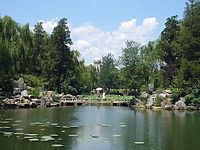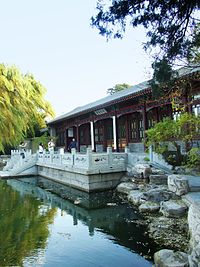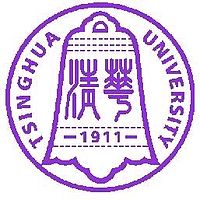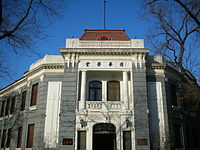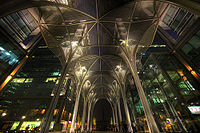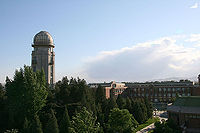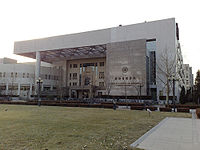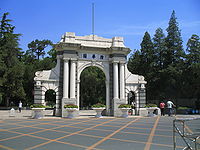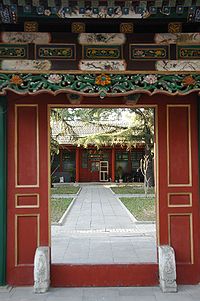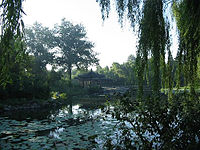- Tsinghua University
-
For the university in Taiwan, see National Tsing Hua University.
Coordinates: 40°00′00″N 116°19′36″E / 40°N 116.32667°E
Tsinghua University 清华大学 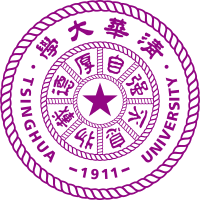
Motto 自强不息, 厚德載物 Motto in English Self-discipline and Social Commitment Established 1911 Type Public President Gu Binglin Academic staff 2,857 Undergraduates 13,915 Postgraduates 12,831 Location Beijing, People's Republic of China Campus Urban, 395 ha (3.95 km²) Flower Redbud and Lilac Colors Purple and White Affiliations AEARU, APRU, C9 Website www.tsinghua.edu.cn 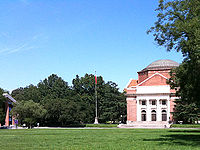 Built in 1917, the Grand Auditorium with its Jeffersonian architectural design is a centerpiece of the old campus
Built in 1917, the Grand Auditorium with its Jeffersonian architectural design is a centerpiece of the old campus
Tsinghua University (Tsinghua; simplified Chinese: 清华大学; traditional Chinese: 清華大學; pinyin: Qīnghuá Dàxué), colloquially known in Chinese as Qinghua, is a university in Beijing, China. The school is one of the nine universities of the C9 League. It was established in 1911 under the name "Tsinghua Xuetang" or "Tsinghua College" and was renamed the "Tsinghua School" one year later. The university section was founded in 1925 and the name "National Tsinghua University" was adopted in 1928. With a motto of Self-Discipline and Social Commitment, Tsinghua University describes itself as being dedicated to academic excellence, the well-being of Chinese society and to global development.[1] Tsinghua is almost always ranked as the first or second best university in mainland China in many national and international rankings.[2][3][4]
History
Further information: Boxer Indemnity Scholarship ProgramSince American Secretary of State John Hay suggested that the US $30 million plus Boxer Rebellion indemnity money paid to the United States was excessive, in 1909, President Roosevelt then obtained congress approval to reduce the Qing Dynasty indemnity payment by $10.8 million USD, on the condition that the said fund was to be used as scholarship for Chinese students to study in the United States. Using this fund, the Tsinghua College (清華學堂 Qīnghuá Xuétáng) was established in Beijing, China, on 22 April 1911 on the site of a former royal garden belonging to a prince.[5] It was first a preparatory school for students later sent by the government to study in the United States. The faculty members for sciences were recruited by the YMCA from the United States and its graduates transferred directly to American schools as juniors upon graduation. In 1925, the school established its College Department and started its research institute on Chinese Study.
In 1928, the authority officially changed its name to National Tsing Hua University (NTHU). During the Second World War in 1937, Tsinghua University along with Peking University and Nankai University, merged to form Changsha Temporary University in Changsha, and later National Southwestern Associated University in Kunming of Yunnan province. After the war, Tsinghua moved back to Beijing and resumed its operation.
After the communist revolution at the end of the Chinese Civil War in 1949, which led to the creation of the People's Republic of China (PRC), Tsinghua University's then President Mei Yi-Qi, followed by many[quantify] professors, fled to Taiwan where they established the National Tsing Hua Institute of Nuclear Technology in 1955, which later became National Tsing Hua University of Taiwan.
In 1952, the Chinese government regrouped the country's higher education institutions in an attempt to build a Soviet style system, with individual institutions tending to specialise in a certain field of study. When the Cultural Revolution began in 1966, many university students walked out of the classrooms, and some went on to be part of the Red Guards, resulting in the complete shut down of the university. Only until 1978 when the Cultural Revolution ended, the university began to take in students again.[6] Tsinghua University was disassembled, losing its law school, school of agriculture, school of sciences and humanities, and became a polytechnic engineering university. Even so, Tsinghua University remained in the top tier schools in China. In many years following this regroup, the school was commonly referred to as the "MIT of China."[7][8][9] But since the 1980s, the university began to incorporate a multidisciplinary system. As a result, several schools were re-incorporated. These included the School of Sciences, School of Business and Management, School of Humanities and Social Sciences, Tsinghua Law School, School of Public Policy and Management, and the Academy of Arts and Design.
Present
Most national and international university rankings place Tsinghua amongst the best universities in mainland China.[2][3][4] Admission to Tsinghua is extremely competitive. Every year, many applicants scoring the highest in the National College Entrance Exams choose Tsinghua. In 2008, 215 out of 300 students who scored the top 10 in the 30 tested provinces and regions chose Tsinghua and 21 out of the 30 top scorers in each province and region chose the university.[10] A majority of selected students are among the brightest high school graduates in the country. Admissions to its graduate schools are also daunting by any measure. For instance, only 16% of MBA applicants are admitted, making it as competitive as the renowned Wharton School MBA program at the University of Pennsylvania.[11] The current CPC General secretary, Chinese president, Hu Jintao, is a former Tsinghua student who graduated with a degree in hydraulic engineering in 1964. The current Chinese vice president, Xi Jinping, is a former Tsinghua student who graduated with a degree in chemical engineering in 1979. The University's Institute of Nuclear and New Energy Technology is on a separate campus in a northern suburb of Beijing.
Tsinghua has a reputation for hosting some of the most distinguished guest speakers of any university in the world, with international leaders such as Bill Clinton, Tony Blair, Henry Kissinger, Carlos Ghosn, and Henry Paulson, all recently giving lectures to the university community.[12]
As of 2003, Tsinghua University had 12 colleges and 48 departments, 41 research institutes, 35 research centers, and 167 laboratories, including 15 national key laboratories. In September 2006, Peking Union Medical College was renamed to Peking Union Medical College, Tsinghua University, although the Peking Union Medical College and Tsinghua University remain two separate institutions.[13] The university offers 51 bachelor's degree programs, 139 master's degree programs and 107 Ph.D. programs. Recently, Tsinghua has become the first Chinese university to offer a Master of Laws program in American law, through a cooperative venture with the Temple University Beasley School of Law. The university is a member of LAOTSE, an international network of leading universities in Europe and Asia. Each year, the University celebrates the Intellectual Property Summer Institute in cooperation with Franklin Pierce Law Center of Concord, New Hampshire. It has its own editorial, Tsinghua University Press.
Schools and departments
- School of Architecture
- Department of Architecture
- Department of Urban Planning and Design
- Department of Building Science
- Department of Landscape Architecture
- School of Civil Engineering
- Department of Civil Engineering
- Department of Hydraulic Engineering
- Department of Construction Management
- School of Mechanical Engineering
- Department of Mechanical Engineering
- Department of Precision Instruments and Mechanology
- Department of Thermal Engineering
- Department of Automotive Engineering
- Department of Industrial Engineering
- School of Aerospace
- Department of Engineering Mechanics
- Department of Aeronautics & Astronautics Engineering
- School of Information Science and Technology
- Department of Electronic Engineering
- Department of Computer Science and Technology
- Department of Automation
- Institute of Microelectronics
- Department of Microelectronics and Nanoelectronics
- School of Software
- Department of Environmental Science and Engineering
- Department of Electrical Engineering
- Department of Engineering Physics
- Department of Chemical Engineering
- Department of Materials Science and Engineering
- School of Sciences
- Department of Mathematics
- Department of Physics
- Department of Chemistry
- School of Humanities and Social Sciences
- Department of Philosophy
- Department of Chinese Language and Literature
- Department of Foreign Languages
- Department of History
- Department of Sociology
- Department of Political Science
- Department of International Relations
- Department of Psychology
- School of Economics and Management
- Department of Management Science and Engineering
- Department of Economics
- Department of Finance
- Department of Accounting
- Department of Innovation and Entrepreneurship
- Department of Human Resources and Organizational Behavior
- Department of Business Strategy and Policy
- Department of Marketing
- School of Public Policy & Management
- Academy of Arts and Design
- Department of Art History
- Department of Industrial Design
- Department of Environmental Art Design
- Department of Ceramic Design
- Department of Visual Communication Design
- Department of Textile and Fashion Design
- Department of Art and Crafts
- Department of Painting
- Department of Sculpture
- Department of Information Art & Design
- School of Medicine
- Department of Medical Science
- Department of Pharmaceutical Science
- Department of Biomedical Engineering
- School of Journalism and Communication
- Institute of Nuclear And New Energy Technology
- Department of Physical Education
School of Economics and Management
The Tsinghua School of Economics and Management (SEM) is consistently ranked one of the best among business schools in China.[16] It was the first mainland Chinese institution outside of Hong Kong to have achieved AACSB and EQUIS accreditations for its business and accounting programs. Founded in 1984, SEM was the first economics and management school in China. Its Founding Dean, Professor Zhu Rongji, later became the fifth Premier of the People’s Republic of China. It is the successor to Tsinghua University's Department of Economics, which was established in 1926.
SEM's International MBA program is one of the most prestigious programs in the People's Republic of China. The entirely English program is offered in collaboration with the MIT Sloan School of Management. The school provides more than 100 MBA courses per year. Upon finishing their required courses, students can select from curricula of different tracks (enterprise management, finance and banking, enterprise innovation and management, accounting analysis and management control, e-commerce, international business administration, etc.). After two years of business and leadership education, students obtain a Masters of Business Administration (MBA) degree from Tsinghua University as well as both a certificate from the MIT Sloan School of Management and MIT Sloan affiliate alumni status. Besides the M.I.T.-Tsinghua International MBA program, international students with Chinese-language skills can also choose to apply to the full-time MBA and the part-time MBA.[17]
SEM also offers an EMBA program in partnership with INSEAD. The Tsinghua-INSEAD Dual Degree Executive MBA program was initiated in 2006, and is the first program of its kind in China combining international business education with a focus on Asia. The program’s first class was opened in the summer of 2007. The program is taught jointly by the two schools’ faculties and focuses on developing the participants’ leadership skills, building their global mindsets, and honing their managerial talents. Upon successful completion of the program, participants are awarded two degrees: an EMBA degree by Tsinghua University and an MBA for Executives degree by INSEAD. Graduates become alumni of the two schools.[18]
There are 8 majors in SEM, namely: management science and engineering, finance, economics, accounting, corporation strategy and policy, marketing, human resources management, and technology economics and management. The school also operates a number of prominent research centers, including: the Research Center for Contemporary Management, the Research Center for Technological Innovation, the National Entrepreneurship Research Center, the China Center for Financial Research, the National Center for Economic Research, the China Retail Research Center, the China Business Research Center, the Center for China in the World Economy, the Research Center for Contemporary Management and Technological Innovation, and the China Insurance and Risk Management Research Center.
Today both SEM's professional and academic programs are considered one of the premier training grounds for China's business leaders.[19]
School of Journalism and Communication
The Tsinghua School of Journalism and Communication (TSJC) was established in April 2002. Its predecessor was Communication Studies in the Department of Chinese Language and Literature and its establishment of coincides with the development of media increasingly influencing world affairs in a time of fast-growing globalization. The school's research fields include International Communication, Film and Television Studies, New Media Studies, Media Operation and Management, and Business Journalism and are based on comprehensive academic research in journalism and communication theories. The objective of the school is to bring full advantage of Tsinghua University's comprehensive academic structure to Chinese and international media, to construct a first-rate discipline in journalism and communication studies, to cultivate talented professionals in the field and to explore advanced concepts in journalism and communication. The school also offers a two-year graduate program in international business journalism, sponsored by Bloomberg L.P. and the International Center for Journalists (ICFJ), that trains talented students and media professionals from around the globe in financial media and corporate communication.[20]
The school has five research-oriented centers to organize and conduct academic research activities. They are: Center for International Communications Studies, Center for New Media Studies, Center for Film and Television Studies, Center for Media Management Studies and Center for Cultural Industry Studies.[20]
The first and present dean of the school is Fan Jingyi, a notable chief editor of People's Daily during the period of 1990s.
Graduate School at Shenzhen, Tsinghua University
The Graduate School at Shenzhen, Tsinghua University, was jointly founded by Tsinghua University and the Shenzhen Municipal Government. The school is directly affiliated with Tsinghua University in Beijing. The campus is located in the University Town of Shenzhen since October 18, 2003.[21]
Rankings
Tsinghua University is frequently ranked amongst the best universities in China. It was ranked 1st in mainland China by China University Ranking,[3] and ranked 1st in mainland China by Netbig in 2009, 2008 and 2007.[22] It was ranked 2nd in mainland China by China's Education Center in 2010, 2009 and 2008,[2] and was ranked 2nd in mainland China by webometrics 2008.[23]
Tsinghua was ranked 47th worldwide by QS World University Rankings in 2011,[24] 58th worldwide by Times Higher Education World University Rankings in 2010,[25] 36th worldwide in Human Resources & Labor Review's Best World Universities 2010,[26] 49th worldwide by US News and World Report (USNEWS),[27] 13th worldwide in the category of engineering and IT by USNEWS, 2009,[28] and ranked 151-200 Worldwide in the Academic Ranking of World Universities by Shanghai Jiao Tong University 2010.[29]
Campus
The campus of Tsinghua University is located in northwest Beijing, in the Haidian district which was designated for universities and other academic institutes.
It is located on the former site of Qing Dynasty royal gardens and retains Chinese-style landscaping as well as traditional buildings, but many of its buildings are also in the Western-style, reflecting the American influence in its history. Along with its rival and neighbor the Peking University, it is known throughout China for having one of the most beautiful campuses. Tsinghua University's campus was named one of the most beautiful college campuses in the world by Forbes in 2010;[30] it was the only university in Asia on the list.[31][32]
T. Chuang, a 1914 graduate of the University of Illinois at Urbana-Champaign, helped design the campus grounds of the Tsinghua University with influences of American architectural style and architectures.[33]
The University's Institute of Nuclear and New Energy Technology is on a separate campus in a northern suburb of Beijing.
Associated people
Main article: People associated with Tsinghua UniversityTsinghua University has produced many notable graduates, especially in political sphere. These include current General secretary, president Hu Jintao, current vice president Xi Jinping, current chairman of the National People's Congress Wu Bangguo, former premier Zhu Rongji, former first vice premier Huang Ju. Tsinghua also has two Nobel Prize winners, Tsung-Dao Lee and Yang Chen Ning. The latter is currently residing on Tsinghua campus. This is a list of people associated with Tsinghua University in China.
Nobel Laureates
- Yang Chen Ning - physicist, Nobel Prize laureate (physics, 1957)
Famous alumni
- Hu Jintao - current General Secretary of the Communist Party of China, President of the People's Republic of China
- Min Chueh Chang - a co-inventor of the combined oral contraceptive pill (1933)
- Shiing-Shen Chern - mathematician, Wolf Prize winner (1984)
- Kai Lai Chung - mathematician
- Mu Dan - poet
- Chao Ko - mathematician
- Zhao Jiuzhang - physicist
- Sun Li-jen - Kuomintang general
- Liang Shih-chiu - scholar
- Wen Yiduo - writer, poet
- Feng Youlan - Chinese philosopher
- Zhang Yuzhe - astronomer
- Fei Xiaotong - researcher of sociology and anthropology
- Qian Zhongshu - one of the most famous writers of pre-Revolutionary China, wrote Fortress Besieged
- Zhou Peiyuan - former president of Peking University
- Wu Guanzheng - member of the Politburo Standing Committee of the Communist Party of China
- Huang Ju - former Vice Premier of the People's Republic of China
- Zhu Rongji - former Premier of the People's Republic of China
- Zhou Xiaochuan - governor of the People's Bank of China
- Jia Chunwang - head of Ministry of State Security 1985-1998, then Minister of Public Security
Famous faculty
 Liang Qichao was one of China's most groundbreaking scholars, journalists, philosophers, and reformists of the 20th century.
Liang Qichao was one of China's most groundbreaking scholars, journalists, philosophers, and reformists of the 20th century.
- Liang Qichao - famous philosopher and reformist during the Qing dynasty
- John L. Thornton - former president and co-chief operating officer of Goldman Sachs
- Tsiang Tingfu - historian and diplomat
- Wu Guanying - designer of the Official mascot of the 2008 Paralympics
- Wang Guowei
- Qin Hui
- David Daokui Li - economist and the Director of the Center for China in the World Economy (CCWE)
- Patrick Chovanec - commentator and consultant on Chinese economy and US-China relations
- Wang Hui
- Laurie Olin - landscape architect and author
- Liang Sicheng - architect and historian
- Lin Huiyin - architect, poet, and historian
- Chen Yinque - historian and linguist
- Norbert Wiener - theoretical and applied mathematician
- Andrew Chi-Chih Yao - Turing Award winner (2001), computer scientist
The Tsinghua Clique
The term Tsinghua clique refers to a group of Communist Chinese politicians that have graduated from Tsinghua University. They are members of the fourth generation of Chinese leadership, and are purported to hold reformist and hesitantly pro-democratic ideas (a number have studied in the United States following graduation from Tsinghua, and some are said to be influenced by the reform ideals of Hu Yaobang). In the PRC, their ascendance to power began in 2008 at the 17th National Congress of the CPC.[34]
Tsinghua graduates who have political prominence are disproportionately greater in number than graduates of other famous universities. Among the nine standing committees at the Politburo, there are four Tsinghua graduates; among the 24 Politburo committee members, there are five; and of all the "leaders of the party and the country", there are 10.
The Tsinghua clique also referred to a group of Nationalist Chinese politicians who held high power in the Republic of China government and fled to Taiwan with the government during the Chinese Civil War. All of them are deceased.
Association of Chartered Certified Accountants partnership
Tsinghua University has signed agreements with the Association of Chartered Certified Accountants (ACCA), the renowned international accountancy body that offers the Chartered Certified Accountant qualification worldwide, to train professional accountants in China. Under the agreement, Tsinghua will develop the programme that under ACCA's syllabus for enabling China's accounting students to join the ACCA professional exam scheme at a higher level. Tsinghua will also recognise the Oxford Brookes University BSc Applied Accounting degree, which has been successfully developed in conjunction with ACCA and which enables students who have completed two parts of the ACCA qualification to apply for the Oxford Brookes degree.[35]
See also
- National Tsing Hua University
- Peking Union Medical College
- Institute of Nuclear and New Energy Technology
- Anti-Corruption and Governance Research Center
- High School attached to Tsinghua University
- Tsinghua clique
- Qinghuayuan
- Wudaokou
- SMTH BBS
- Education in the People's Republic of China
- List of colleges and universities in Beijing
- The Students' English Debating Association (SEDA), Tsinghua University
References
- ^ Introduction of Tsinghua University
- ^ a b c University in China. China Education Center
- ^ a b c 2009 China University Ranking
- ^ a b Univ ranking in China 200
- ^ Su-Yan Pan (2009). University autonomy, the state, and social change in China. Hong Kong University Press. p. 68. ISBN 9789622099364.
- ^ 方惠坚,张思敬 (2001) (in zh). 清华大学志(下册)(M). 北京: 清华大学出版社. pp. 781–785. ISBN 7-302-04319-1.
- ^ http://news.harvard.edu/gazette/2002/05.16/11-china.html
- ^ Transcript of Premier Zhu Rongji's speech at MIT
- ^ http://www.usembassy-china.org.cn/press/release/1999/tsinghua.html
- ^ Programs and Degrees
- ^ Business Week
- ^ http://mba.sem.tsinghua.edu.cn/Portals/1/Containers/Tsinghua%20SEM%20International%20MBA%20Program.pdf
- ^ Inauguration Ceremony for Newly Named Peking Union Medical College, Tsinghua University
- ^ News of Tsinghua University Tsinghua University
- ^ Website of School of Life Sciences, Tsinghua University School of Life Sciences, Tsinghua University
- ^ http://www.sem.tsinghua.edu.cn/jg_en/infoSingleArticle.do?articleId=1664&columnId=1059
- ^ http://mba.sem.tsinghua.edu.cn/tabid/152/Default.aspx
- ^ Tsinghua INSEAD EMBA Programme
- ^ "Regional expertise is a priority." Financial Times
- ^ a b TSJC in brief
- ^ Overview of Graduate School at Shenzhen, Tsinghua University
- ^ [1]
- ^ webometrics
- ^ http://www.topuniversities.com/university-rankings/world-university-rankings/2011
- ^ "THE World University Rankings 2010". Times Higher Education. http://www.timeshighereducation.co.uk/world-university-rankings/2010-2011/top-200.html.
- ^ "300 Best World Universities 2010". ChaseCareer Network. http://www.chasecareer.net/news_detail.php?id=61.
- ^ World's Best Universities. US News and World Report
- ^ World's Best Universities: Engineering and IT
- ^ Academic Ranking of World Universities - 2010
- ^ Yale named among world’s ‘most beautiful campuses’
- ^ Forbes Magazine lists University of Cincinnati among world's most beautiful college campuses
- ^ le Draoulec, Pascale (1 March 2010). "The World's Most Beautiful College Campuses". Forbes. http://www.forbes.com/2010/03/01/most-beautiful-campus-lifestyle-college.html. Retrieved 8 March 2010.
- ^ Melissa Mitchell (2007-02-15). "Global partnership aims to train 'exceptional' professional". UIUC News Service. http://www.news.uiuc.edu/news/07/0215partnership.html. Retrieved 2007-07-10.
- ^ China's elite politics: political transition and power balancing
- ^ http://www.accaglobal.com/news/releases/2409519
External links
- (Chinese) Home Page
- (English) Home Page
- (Chinese) Tsinghua University Library
- (English) Tsinghua University Library
- (Chinese) Tsinghua University News
- (English) Tsinghua University News
- Campus real three-dimensional map
- [2]
Association of East Asian Research Universities China Hong Kong SAR of CHINA Korea KAIST • POSTECH • Seoul National (SNU)Taiwan Japan Association of Pacific Rim Universities (APRU) China Hong Kong Japan South Korea Russia Canada Mexico United States Caltech · Stanford · UC Berkeley · UC Davis · UC Irvine · UCLA · UCSD · UCSB · Oregon · Southern California (USC) · WashingtonAustralia New Zealand Chile Indonesia Malaysia Philippines Singapore Taiwan Thailand C9 League Project 985 Beijing (8) Peking University · Tsinghua University · Beihang University · Beijing Institute of Technology · Renmin University of China · Beijing Normal University · China Agricultural University · Minzu University of ChinaShanghai (4) Zhejiang (1) Jiangsu (2) Anhui (1) Shaanxi (3) Heilongjiang (1) Jilin (1) Liaoning (2) Tianjin (2) Shandong (2) Gansu (1) Hubei (2) Hunan (3) Fujian (1) Chongqing (1) Sichuan (2) Guangdong (2) Project 211 Beijing Foreign Studies University · Beijing Forestry University · Beijing Institute of Technology · Beijing Jiaotong University · Beijing Normal University · Beihang University · Beijing University of Chemical Technology · Beijing University of Chinese Medicine · Beijing University of Posts and Telecommunications · Beijing University of Technology · Peking Union Medical College · Peking University · Renmin University of China · Tsinghua University · Central Conservatory of Music · Central University of Finance and Economics · China Agricultural University · China University of Geosciences · China University of Mining and Technology · China University of Political Science and Law · Communication University of China · University of International Business and Economics · University of Science and Technology Beijing · Minzu University of China · North China Electric Power UniversityShanghai International Studies University · Shanghai Jiao Tong University · Shanghai University · Shanghai University of Finance and Economics · Fudan University · Donghua University · East China Normal University · East China University of Science and Technology · Tongji University · Second Military Medical UniversityHainan UniversitySoutheast University · Nanjing Agricultural University · Nanjing Normal University · Nanjing University · Nanjing Aeronautics and Astronautics University · Nanjing University of Science and Technology · Soochow University · China Pharmaceutical University · Jiangnan University · Hohai UniversityUniversity of Electronic Science and Technology of China · Sichuan Agricultural University · Sichuan University · Southwest Jiaotong University · Southwestern University of Finance and EconomicsCDIO Africa Asia-Pacific Chisholm Institute (Australia) · Queensland University of Technology (Australia) · University of Sydney (Australia) · Beijing Jiaotong University (China) · Chengdu University of Information Technology (China) · Shantou University (China) · Tsinghua University (China) · Kanazawa Technical College (Japan) · Taylor's University (Malaysia) · University of Auckland (New Zealand) · Singapore Polytechnic (Singapore) · Vietnam National University, Ho Chi Minh City (Vietnam)
Europe Hogeschool Gent (Belgium) · University College Leuven (Belgium) · Engineering College of Aarhus (Denmark) · Technical University of Denmark · Lahti University of Applied Sciences (Finland) · Metropolia University of Applied Sciences (Finland) · Seinäjoki University of Applied Sciences (Finland) · Turku University of Applied Sciences (Finland) · Telecom Bretagne (France) · Hochschule Wismar (Germany) · Politecnico di Milano (Italy) · Instituto Superior de Engenharia do Porto (Portugal) · Universitat Politècnica de Catalunya (Spain) · Chalmers University of Technology (Sweden) · Jönköping School of Engineering (Sweden) · Linköping University (Sweden) · Royal Institute of Technology (Sweden) · Umeå Institute of Technology (Sweden) · Aston University (UK) · Queen's University Belfast (UK) · University of Bristol (UK) · Lancaster University (UK) · University of Liverpool (UK) · University of Leeds (UK) · University of Strathclyde (UK)
North America École Polytechnique de Montréal (Canada) · Queen's University (Canada) · University of Calgary (Canada) · University of Manitoba (Canada) · Arizona State University (United States) · California State University (United States) · University of Colorado (United States) · Daniel Webster College (United States) · Duke University (United States) · Embry-Riddle Aeronautical University (United States) · Massachusetts Institute of Technology (United States) · University of Michigan (United States) · Pennsylvania State University (United States) · United States Naval Academy
Central and
South AmericaUniversity of Chile · Universidad Católica de la Santísima Concepción (Chile) · Universidad de Santiago de Chile (Chile) · Pontificia Universidad Javeriana (Colombia) · UNITEC Laureate International Universities (Honduras)
Categories:- Association of Pacific Rim Universities
- Lists of people by university in China
- Project 211
- Project 985
- Tsinghua University
- Universities and colleges in Beijing
- Educational institutions established in 1911
- School of Architecture
Wikimedia Foundation. 2010.

